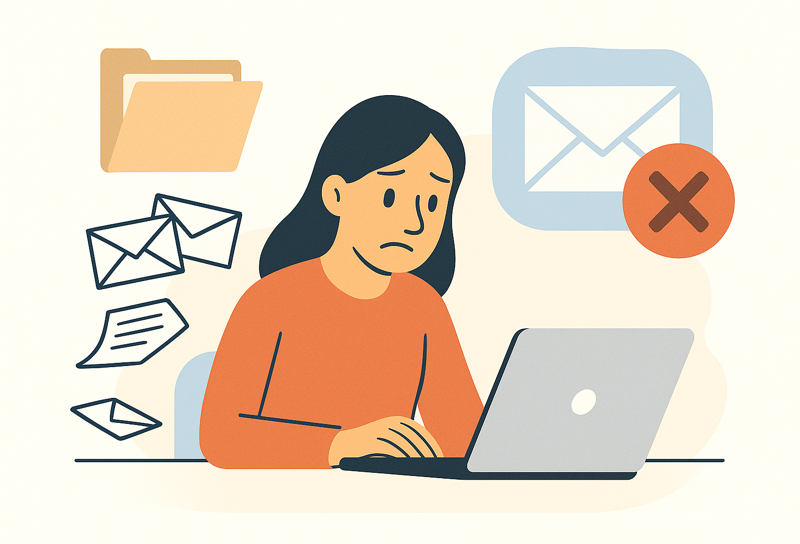About the author:
Darren Blumenfeld is the CEO and Founder of InboxAlly, an email deliverability platform trusted by growth-focused marketers. He’s previously founded HonestMail, worked at NASA, and holds degrees from Tufts and Columbia. His passion for tech, education, and creativity continues to inspire innovation in email outreach.
If you’re a business person or an entrepreneur, one of the classic ways to reach out to a potential prospect is through both cold emails and calls. Both are effective outreach methods, especially when you use the right software to track and improve your results. Therefore, we will compare cold email vs. cold call on a scale to see which works best.
However, the billion-dollar question is, do the two methods still work in 2025? If yes, how do you go about it to ensure you close that prospect, and which method do you use? It’s important to decide which approach aligns best with your goals and audience, as making a clear decision can significantly impact your prospect engagement and sales outcomes.
If you’ve had these questions, stay tuned to learn more. Choosing the right method makes sense when you consider your business objectives and available resources.
Introduction to Cold Outreach
Cold outreach is still one of the most effective ways to start conversations and build new business relationships. It essentially means reaching out to people who don’t know your brand yet, whether through a phone call or an email, with the hope of turning them into customers.
With the right approach, cold outreach can generate leads, open doors, and kick off long-term partnerships. The two most common methods you’ll see are cold calling and cold emailing. Cold emails give you a chance to introduce your company in writing, while cold calls can be better when you want to connect instantly and read the person’s tone, though both take skill to do well.
Which one works better depends highly on your audience, your offer, and your overall strategy. A thoughtful approach to both can make a huge difference in whether people respond to or ignore you.
What is a Cold Call?
![]()
A cold call is when you reach out to a new prospect through a phone call, attempting to sell them your product or service. The word “cold” means there hasn’t been any previous interaction between the caller and the receiver, or in other words, they’re strangers.
According to recent data from Zippia, cold calling only has a 2% success rate. However, do not worry; this number climbs to 18% when the lead or prospect has been highly pre-qualified. [1] This study means the success of your cold outreach campaign depends on the quality, not quantity, of your prospect list.
The following section will examine the benefits and drawbacks of using a cold call to get new customers:
Benefits and Drawbacks of Cold Calling
Cold calling is an effective way to reach potential customers, build relationships, and grow your business. It is an old-school form of marketing that has been around for decades, yet it is a booming business method.
Here are some of its benefits and drawbacks to help you make an informed decision:
4 Benefits of Cold Calls
1. Learn About Your Prospect Directly
It’s much easier to gauge a prospect’s interest in what you’re selling when you talk to them directly rather than waiting for a response to an email or other form of outreach. You can also get a good idea of the prospect’s needs and how likely they will buy from you.
The direct feedback from a call refines your sales process and makes adjustments to ensure you provide the best possible service to your prospects.
2. Instant Feedback
When you send an email or other form of outreach, you’re unsure if the prospect will open it and read it. However, with a call, you can be sure the prospect will hear your message and respond. This is especially true if you use a personal reference or another form of contact.
3. Master Your Craft Over Time
Cold calling takes a certain amount of skill and practice. But if you commit to it, you can become an expert cold caller. With enough practice, you can learn the best way to approach a prospect, the best time to call, and the best way to craft compelling sales calls or pitches.
4. Makes your Business Appear Professional and Human
When you make a call, you show that you care about the customer and are taking the time to contact them directly. Cold calling makes an excellent first impression and shows that you’re serious about making a sale, even if it comes with a higher total cost compared to other methods.
Moreover, cold calling allows you to explain your services in more detail than an email or other form of cold outreach can. You can also use this opportunity to explain why your services are the best for the customer and how you can solve their problems.
4 Drawbacks of Cold Calls
1. Time Consuming
One of the most significant drawbacks of cold calling is it can consume so much of your time. So, you must ensure you’re calling the right prospects at the right time with the right message. Doing this takes a lot of time and effort, and keeping track of all your phone calls can be difficult.
Moreover, keeping track of who you’ve called and still need to call can be challenging if you manually call prospects.
2. It Can be Annoying
People don’t usually like to receive unsolicited calls. Traditional cold calls occurred in a more physical setting, such as door visits. But with modern cold calling, it happens in a borderless setting and is run through auto-diallers.
So, ensuring you’re respectful and courteous when making a call is essential. Also, ensure you’re not interrupting the prospect during a critical time.
If you’re cold calling at mid-day, be prepared to leave a message or reschedule the call for a better time when the prospect is likely not busy.
3. Reaching Decision Makers is Hard
With both cold calling and email outreach, it can take time to reach the potential client you’re aiming for. In larger companies, it’s especially hard to get past gatekeepers and speak directly with decision makers.
That’s why in your initial outreach, you might have to win over a receptionist or coordinator before you can speak to the right person.
4. Limited Time to Engage
Most prospects don’t want to spend more than a few minutes with sales reps, so keeping your call short and straight to the point is essential.
Additionally, focus on getting the prospect’s contact information and arranging a follow-up call or meeting rather than trying to make a sale on the first call. Here’s a guide on how long you should last on a cold call and what to say.
5 Cold Calling Best Practices
1. Keep it Short
Introduce yourself and your business, and quickly explain why you’re cold calling and how you can help the prospect.
Ensure you’re also giving the prospect enough information to make an informed decision, but not so much that it overwhelms them. Be prepared to answer any questions that the prospect may have as well.
2. Learn About the Prospect Beforehand
Before cold calling, it’s essential to research the prospects before moving them to the next stage of the sales funnel. Therefore, learn about the prospect’s needs, interests, and buying habits. As a result, you will craft a more compelling sales pitch and ensure you’re targeting the right prospects.
3. Keep it Friendly and Personable
When cold calling, it’s essential to keep it friendly and personable. So, ensure you’re not speaking too quickly or trying to rush the conversation.
It’s also essential to take your time. Don’t forget to ensure that the prospect is comfortable and has enough time to ask any questions they may have.
4. Call During the Appropriate Time
You should only call when prospects are likely available, not when they’re probably busy. Therefore, ensure you’re not cold calling too early or too late in the day.
5. Record your Cold Call
It’s essential to record your cold call to review it later. Doing this ensures you’re providing the best possible service to the prospect. It will also refine your sales pitch and target the right prospects.
Recording cold calls also helps you learn from your mistakes and become a better cold caller. You can use the recordings as a learning tool to become an expert cold caller.
What is a Cold Email?
Cold emailing is a form of direct marketing that involves sending unsolicited emails to potential customers and partners. Here’s how it works and what results you can expect from it.
Benefits and Drawbacks of Cold Emailing
Cold emailing also brings unique pros and cons to your sales outreach strategy. Understanding its strengths and limitations can help you decide whether it’s the right approach for engaging your prospects.
4 Benefits of Cold Emails
1. Increases Brand Awareness
Cold emails increase brand awareness by including more information about your company, products, and services.
As a result, it becomes easier for prospects to learn more about your business and become familiar with it. They can then make an informed decision on whether or not to purchase your product or service.
2. Automates and Tracks your Emails
One of the most significant advantages of cold emailing is that you can automate the process. Doing this makes it easier to send out a large number of cold emails in a relatively short amount of time.
You can also customize your email content based on your target audience buyer personas. Doing this ensures that your emails are relevant and tailored to your prospects.
3. Highly Affordable
Another advantage of email outreach is how cost effective it is compared to making cold calls. For instance, you don’t need accurate phone numbers, you don’t have to block off time for voice conversations, and you can reach hundreds of prospects with a single campaign.
This is a great benefit if you’re running a lean lead generation campaign or just beginning to scale your sales prospecting.
4. Warms Up Cold Leads
Cold emails are also easier to warm up compared to cold calls. When you make a cold call, you have to rely on your sales skills and closing abilities to establish a connection with the prospect.
However, you can provide valuable information about your company and products with cold emails. You can also use this information to build a relationship with your target audience slowly. As a result, generating leads and getting a response from the prospect becomes easier.
5 Drawbacks of Cold Emails
1. Ends Up in the Spam Folder
Your cold emails might end up in spam. This can also happen if your emails need to be correctly optimized for spam filters or if you send too many emails quickly.
2. Time Consuming
Cold emailing can consume your time since you must craft and optimize each email for the recipient’s tone and interests. Additionally, you must research the intended recipients and ensure your emails are sent to the right people.
3. Difficulty Closing a Lead
Cold emails are limited in terms of the amount of information that you can include in the message. Additionally, assessing the prospect’s tone and interests through a cold email is challenging. This makes closing a lead over a cold email more complex than a cold call.
4. High Competition
When cold emailing, it is vital to use an email deliverability tool. This tool ensures that your emails reach the intended potential customer and that spam filters do not block them.
InboxAlly uses seed emails that interact with your emails by removing them from the spam or promotions folder and sending them to the primary inbox. This shows email service providers that your emails are important and should be sent directly to the primary inbox in the future.
5 Cold Emailing Best Practices
1. Personalize Your Cold Email
When it comes to cold emails, personalization is critical. You should always take the time to tailor your emails to the recipient’s interests, needs, and tone.
Additionally, you should include relevant data points, for example, the recipient’s name and company. This ensures that your personalized cold emails stand out from the crowd and are more likely to be opened and read.
2. Send Your Emails at the Appropriate Time
Avoid sending emails too early in the morning or too late at night. Additionally, consider holidays and other events that might affect when your emails are sent. Here’s a detailed guide on the best time to send your cold email.
3. Keep it Short and Direct
Your emails should be at most five sentences. Instead, they should include only the most pertinent information. This ensures that your emails are read and the recipient quickly understands your message.
4. Use an Email Deliverability Tool
When cold emailing, it is vital to use an email deliverability tool. This tool ensures that your emails reach the intended potential customer and that spam filters do not block them.
InboxAlly uses seed emails that interact with your emails by removing them from the spam or promotions folder and sending them to the primary inbox. This shows email service providers that your emails are important and should be sent directly to the primary inbox in the future.
5. Perfect Your Subject Lines
Finally, it is essential to create a compelling subject line. It is the first thing the recipient will see, so ensuring it is engaging and relevant is vital.
Additionally, you should avoid using too many exclamation points or other gimmicks in your subject line. Here are some compelling subject lines that’ll get your email opened and read.
Measuring Success in Cold Outreach
Tracking the effectiveness of your cold outreach is key to refining your sales strategy and achieving better results. For cold emailing, important metrics include open rates, response rates, click-through rates, bounce rates, and unsubscribe rates. These data points help sales reps understand how well their email campaigns are performing highlight the key differences between what’s working and what needs improvement.
For cold calling, success is measured by metrics such as call connect rates, conversation rates, and the number of meetings scheduled as a result of phone calls. It’s also important to track the number of qualified leads generated and deals closed through both cold emailing and cold calling.
By regularly analyzing these metrics, sales reps can identify what’s working, adjust their outreach efforts, and ensure that their sales pipeline remains healthy and productive.
Future of Cold Outreach
Looking ahead, the future of cold outreach will be shaped by a blend of advanced technology and the enduring value of human connection. As AI and machine learning become more sophisticated, sales reps can use these tools to craft highly personalized emails, predict the best times to reach out, and automate routine tasks, making cold outreach more efficient and effective.
However, technology alone isn’t enough. The personal touch makes a big difference, whether it’s a thoughtful email or a genuine phone conversation, remains essential for building trust and closing deals. The most successful sales reps will find the perfect balance between leveraging technology and maintaining authentic, human interactions with prospects.
The future of cold outreach is all about combining smart automation with a personal approach to create meaningful connections and lasting business growth.
Conclusion: Which is Better?
Cold emails and cold calls each have their place, but they play different roles. If you want reach and efficiency, cold emailing lets you cast a wide net. If you’re after real-time feedback and rapport, nothing beats a phone call.
The smart move? Test both, see what resonates with your audience, and refine from there. And if you’re serious about getting your emails actually read, make sure they land in the inbox, not the spam folder. That’s where a tool like InboxAlly gives you an edge.


